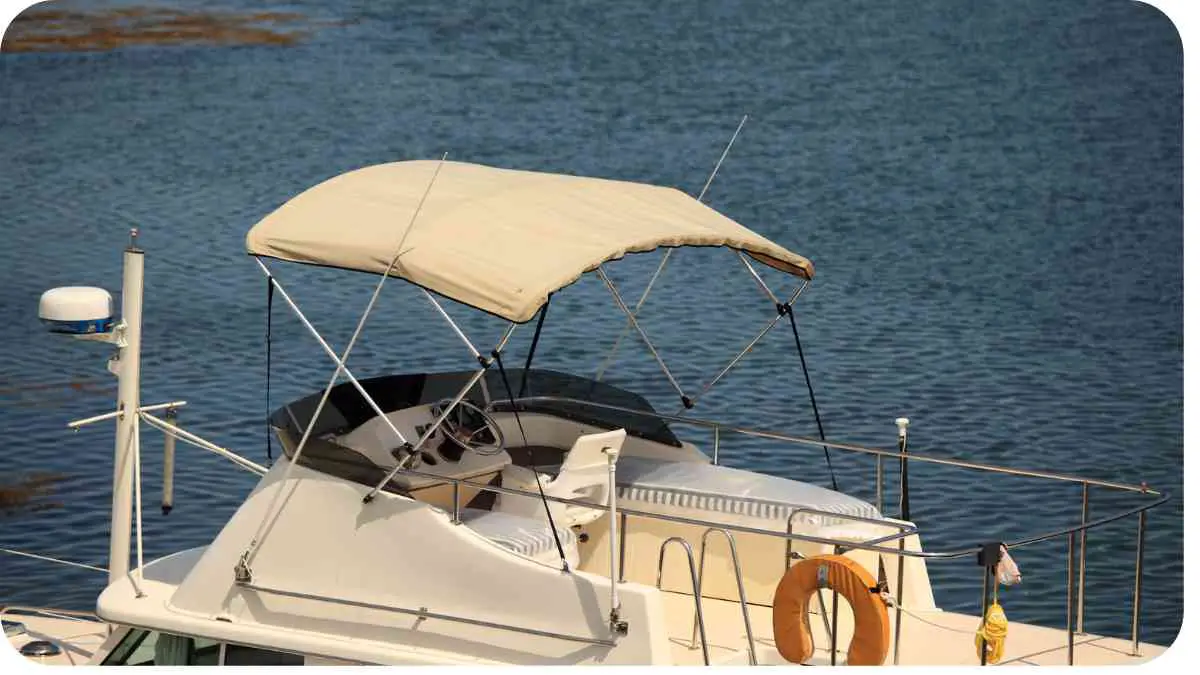Boating is a thrilling adventure, but it comes with its fair share of maintenance responsibilities. One common issue that boat owners encounter is canopy damage. Whether it’s due to wear and tear or unexpected accidents, knowing how to patch a boat canopy is a valuable skill every boater should possess.
In this comprehensive guide, we’ll walk you through the process of patching a boat canopy step by step. From understanding the types of damage to choosing the right patch material and applying it correctly, you’ll learn everything you need to know to keep your canopy in top condition.
| Takeaways |
|---|
| 1. Regularly inspect your boat canopy for signs of damage, such as tears, punctures, fraying, or seam damage. |
| 2. Choose the appropriate patch material based on the type and extent of the damage, ensuring it provides a strong and durable repair. |
| 3. Proper preparation, including cleaning and drying the canopy surface before applying the patch, is essential for ensuring good adhesion. |
| 4. Follow the manufacturer’s instructions for applying and curing the patch material to achieve the best results. |
| 5. Reinforce the patched area for added durability, especially for larger tears or areas prone to high stress. |
| 6. Test the patch for water resistance and durability before exposing your boat canopy to harsh weather conditions. |
| 7. Implement regular maintenance practices, such as cleaning, storing properly, and applying UV protectant treatments, to prolong the lifespan of your boat canopy. |
Understanding Boat Canopy Damage

Before diving into the patching process, it’s essential to understand the different types of damage your boat canopy may encounter and what causes them.
When stability wavers, follow our guide to fix it. Discover solutions ensuring your Home Depot pergola stands firm against nature’s tests.
Common Causes of Boat Canopy Damage
| Cause | Description |
|---|---|
| UV Exposure | Prolonged exposure to sunlight can weaken the canopy fabric. |
| Harsh Weather Conditions | Wind, rain, and hail can cause tears or punctures. |
| Accidental Damage | Collisions with branches, docks, or other objects. |
| Wear and Tear | Continuous use over time can lead to degradation. |
Types of Damage
| Type | Description |
|---|---|
| Tears | Straight or jagged cuts in the canopy fabric. |
| Punctures | Small holes caused by sharp objects. |
| Fraying | Threads coming loose from the edges of the fabric. |
| Seam Damage | Separation or tearing along the seams of the canopy. |
Understanding the cause and type of damage will help you assess the extent of the problem and determine the most effective patching method.
Assessing the Damage
Once you’ve identified the type of damage your boat canopy has sustained, it’s time to assess its severity.
Visual Inspection
Start by visually inspecting the entire canopy surface. Look for any tears, punctures, fraying, or seam damage. Take note of the size and location of each issue.
Combat uneven terrain effectively with Lowe’s pergola installation tips. Ensure your structure stands tall, even on challenging grass surfaces.
Structural Integrity Check
Next, check the structural integrity of the canopy frame. Ensure that there are no bent or broken poles, as these may need to be repaired or replaced in addition to patching the fabric.
Gathering Materials and Tools
Before you begin the patching process, gather all the necessary materials and tools.
Materials Needed
| Material | Description |
|---|---|
| Patch Material | Depending on the type of damage (e.g., patch tape, patch kit, patch fabric). |
| Cleaning Solution | Mild detergent or specialized canopy cleaner. |
| Patch Adhesive | Waterproof adhesive suitable for canopy fabric. |
| Reinforcement Material | Optional: additional fabric or patch reinforcement tape. |
Tools Required
| Tool | Description |
|---|---|
| Soft Bristle Brush | For cleaning the canopy fabric. |
| Scissors | For cutting patch material to size. |
| Rag or Towel | For drying the canopy surface. |
| Heat Source | Optional: heat gun or hairdryer for curing the adhesive. |
Preparing the Canopy for Patching
Proper preparation is crucial for ensuring the patch adheres securely to the canopy fabric.
Elevate your canopy with expert advice on fabric replacement. Restore its charm and functionality for extended outdoor enjoyment.
Cleaning the Area
Using a soft bristle brush and a mild detergent solution, gently scrub the damaged area to remove any dirt, grime, or salt residue. Rinse thoroughly with water and allow the surface to dry completely.
Drying the Surface
After cleaning, use a clean rag or towel to dry the canopy surface thoroughly. Ensure there is no moisture remaining, as it can affect the adhesion of the patch.
In the next sections, we’ll delve into choosing the right patch material, applying the patch, curing and reinforcing it, and testing the patch for durability. Stay tuned for expert tips and detailed instructions to help you successfully patch your boat canopy!
Choosing the Right Patch Material
Selecting the appropriate patch material is crucial for ensuring a durable and effective repair.
Comparison Table of Patch Materials
| Patch Material | Pros | Cons |
|---|---|---|
| Patch Tape | Easy to apply | May not be as durable as other materials |
| Patch Kit | Includes all necessary materials | Limited options for customization |
| Patch Fabric | Provides strong, long-lasting repair | Requires adhesive for application |
Consider the extent of the damage, the material of your canopy, and your preference for ease of application when choosing the patch material.
Repair canopy damage seamlessly using our hole-fixing techniques. Preserve your canopy’s integrity and enjoy uninterrupted shade
Applying the Patch
Now that you’ve gathered your materials and prepared the canopy, it’s time to apply the patch.
Step-by-Step Guide
- Cutting the Patch: Using scissors, cut the patch material to a size slightly larger than the damaged area.
- Applying Adhesive: Apply a thin layer of waterproof adhesive to the back of the patch and to the damaged area of the canopy.
- Placing the Patch: Carefully place the patch over the damaged area, ensuring it overlaps the edges of the tear or puncture.
- Pressing Firmly: Press down firmly on the patch to ensure good adhesion and remove any air bubbles.
- Allowing to Cure: If using adhesive that requires curing, follow the manufacturer’s instructions for the appropriate curing time.
Tips for Successful Application
- Ensure the canopy surface is clean and dry before applying the patch.
- Apply pressure evenly across the patch to ensure a secure bond.
- Consider using a roller or smooth object to press down on the patch and remove any wrinkles or bubbles.
Shield your canopy from the elements with our sealing strategies. Extend its lifespan and maintain its pristine condition effortlessly.
Curing and Reinforcing the Patch
After applying the patch, it’s essential to allow it to cure fully and reinforce it for added strength.
Curing Process
If you’re using adhesive that requires curing, follow the manufacturer’s instructions regarding the curing time and temperature. Avoid exposing the patch to water or harsh weather conditions during the curing process.
Reinforcement Techniques
For added durability, consider reinforcing the patch with additional fabric or patch reinforcement tape. Apply the reinforcement material over the patch, extending beyond the edges, and secure it with adhesive.
Testing the Patch
Once the patch has been applied and cured, it’s essential to test its effectiveness.
Water Resistance Test
To test the patch’s water resistance, simulate rainy conditions by spraying water onto the patched area with a hose or watering can. Observe whether any water seeps through the patched area or if the patch remains dry and secure.
Durability Test
Conduct a durability test by gently pulling on the edges of the patch to ensure it remains firmly adhered to the canopy fabric. Additionally, inspect the patch for any signs of peeling, lifting, or deterioration.
Additional Tips for Canopy Maintenance

Maintaining your boat canopy is key to prolonging its lifespan and preventing future damage. Here are some additional tips to keep in mind:
- Regular Inspections: Perform routine inspections of your boat canopy to check for any signs of wear and tear. Address any issues promptly to prevent them from worsening over time.
- Storage Tips: When not in use, store your boat canopy in a dry, well-ventilated area away from direct sunlight and harsh weather conditions. Consider using a canopy cover or storage bag to protect it from dust and debris.
- UV Protection: Invest in UV protectant sprays or treatments to shield your canopy fabric from the damaging effects of the sun’s UV rays. Apply these treatments regularly to maintain optimal UV resistance.
- Repair Promptly: If you notice any damage to your canopy, such as tears, punctures, or fraying, repair it as soon as possible to prevent further deterioration. Ignoring minor damage can lead to more extensive repairs down the line.
Conclusion
Patching a boat canopy may seem like a daunting task, but with the right materials, tools, and know-how, it can be a straightforward process. By following the steps outlined in this guide and implementing proper maintenance practices, you can keep your boat canopy in excellent condition for years to come.
Remember to assess the damage, choose the appropriate patch material, and follow the recommended application techniques for the best results. Regular inspections and maintenance will help prolong the lifespan of your canopy and ensure many more enjoyable boating adventures ahead.
If you have any questions or need further assistance with patching your boat canopy, don’t hesitate to reach out to a professional or experienced boater for guidance. Happy boating!
Further Reading
- How to Repair or Patch a Hole or Tear in a Boat Cover: Provides detailed instructions and tips for repairing holes or tears in boat covers.
- Boat Cover Repair Guide: A comprehensive guide to repairing various types of damage to boat covers, including tears, punctures, and seam damage.
- Canvas Repair: Rips & Tears: Offers step-by-step instructions and video tutorials for repairing canvas fabric, including rips and tears commonly found in boat canopies.
FAQs
How do I identify damage to my boat canopy?
Damage to your boat canopy can manifest in various forms, including tears, punctures, fraying, and seam damage. Inspect your canopy regularly for any signs of wear and tear.
What materials do I need to patch a boat canopy?
To patch a boat canopy, you’ll typically need patch material (such as patch tape or fabric), adhesive, cleaning solution, scissors, and a soft bristle brush for cleaning.
Can I patch a boat canopy myself, or do I need professional help?
While minor repairs can often be done DIY, more extensive damage may require professional assistance. Assess the severity of the damage before deciding whether to tackle the repair yourself.
How long does it take to patch a boat canopy?
The time required to patch a boat canopy depends on the extent of the damage and the type of patch material used. Simple repairs may take just a few hours, while more complex repairs may take longer.
How can I prevent future damage to my boat canopy?
Regular maintenance, including cleaning, inspecting, and storing your canopy properly when not in use, can help prevent future damage. Additionally, investing in UV protectant treatments can help prolong the life of your canopy fabric.

I am Hellen James, a professional handywoman with expertise in improving home and garden spaces by using pergolas, gazebos, and tents.


